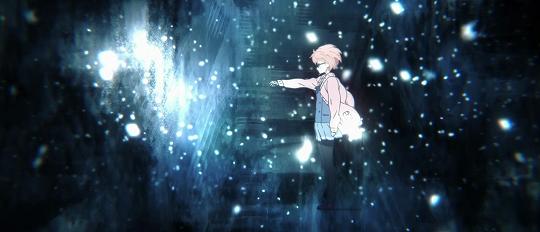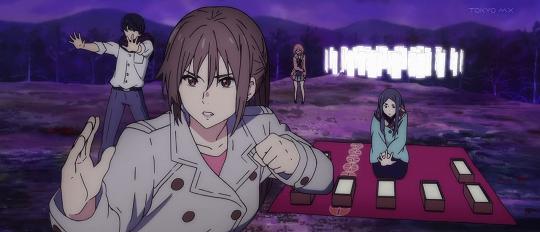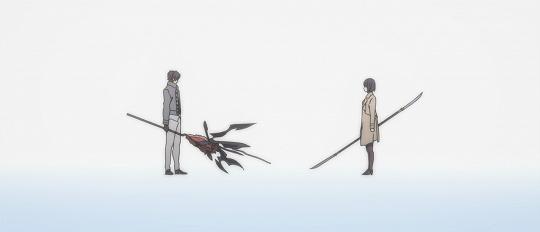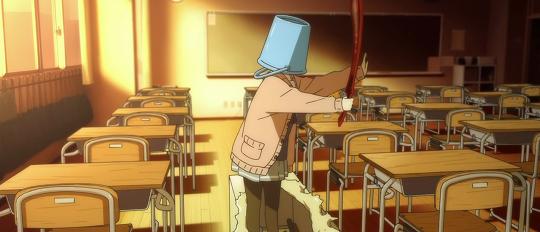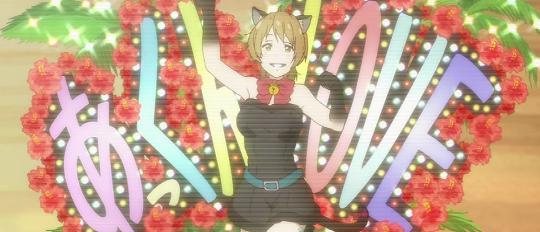On the one hand, Kyoukai no Kanata (Beyond the Boundary) is true to its heritage as a Kyoto Animation work: rich with detail and character nuance. On the other hand the series is outside the studio’s normal comfort zone with a fantasy setting and combat at its core. And on yet another hand - and this is the one that slaps you - there’s episode six; an episode so unbelievably stupid it’s almost impossible to align it with the five episodes that came before, or the six that follow.
The episode in question takes the story so far - a girl Mirai, from a reviled sect of spirit hunters, has ingratiated herself with a town’s local populace, not least of all the immortal half-human half-spirit Akihito - and tosses in three bath scenes and a dance number with a set up so ridiculous that abandoning the series there and then would be more than justified. The first episode was vexing enough with Mirai doing almost everything in her power to prevent the audience from empathising with her.
There is a good story reason for that standoffishness but it isn’t until you’ve weathered a selection of po-faced character introductions and a weird dearth of world building that it is revealed. This is to say nothing of the ending that, exactly like Tasogare Otome x Amnesia, promises to be poignantly bittersweet but tosses away its respect and continuity seconds from the closing credits.
All of this is a very negative kick-off to what is a well produced but peculiarly mediocre series. The surface is, expectedly, gorgeous with a real sense of character to the small town run by a dynasty of spirit hunters and with an enticing, hidden ecosystem to the spirits, or “dreamshades” in the series’ parlance. But enticement is all there is, we are never gifted with more information about either its characters - how did Akihito become half-spirit? is Mirai the last of her bloodline? - or its world - who is the person beneath the Nase mansion? what exactly does the Spirit Hunter Association do?
Instead we get the story of two outcasts, pariahs of their own kind cursed either by circumstance or lineage, who find solace in one another and eventually acceptance for their own feelings towards their situation. The world may still treat them as tools or even as taboos in the historical Shinto sense (burakumin) but they both come to terms with that. It’s a strong theme and is bolstered by secondary characters like Sakura accepting the death of her loved one, or Hiroomi understanding the duty both he and his sisters have inherited from their family; both contributing to the underlying thread of accepting that which the characters have no control over.
But that story is less interesting than everything else that we are teased with and, crucially, is scuppered by a devotion to fan service that would otherwise only improve what was there. Koyoto Animation has demonstrated its understanding of fan service before: that at a fundamental level it is about the incidental details even when their inclusion is anything but. Little tics like Mirai wiping her glasses when she is embarrassed, even when she isn’t actually wearing them, or the peppy Ai stroking Mirai’s hair, or any number of other little mannerisms. Elements like a photo shoot dressed as a maid or the constant references to the fetishes of the two main male characters feel like they have been crowbarred in, blatant and hamfisted and ignoring the deftness that other series from the studio have shown.
Which brings us back to episode six. Dance numbers are the studio’s signature - Lucky Star, Haruhi, K-On etc. - understood, but the setup for it here is so transparent as to be almost embarrassing. That episode doesn’t break the series (though it gives it a good go) but is indicative of more pressing issues roiling beneath the aesthetic sheen.
The spirit design is superb but suffers from just increasing in size. The battles are blinding and graceful but often devolve into a blur of blows quite apart from the lucid super-powered shenanigans seen before. Symbolism is rife with religious murals in the park to the tunnel of the opening. The list goes on, but it’s all for naught against an oddly drab story.
The best way of summarising Kyoukai no Kanata then is that it is another decent production by Kyoto Animation. It’s another series that you can’t gush about with unfettered praise or plunge the knife into to end its awfulness. It’s entertaining and pretty and alluring and fan servicey and by comparison to so many other series stands well above them in almost all regards. But the curse of expectation follows those who make their name with stellar, peerless output; so it feels a little like a spoiled brat when saying that it’s good, but not without its problems.
